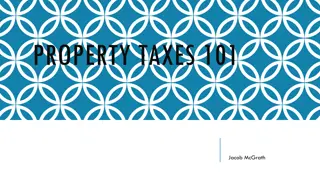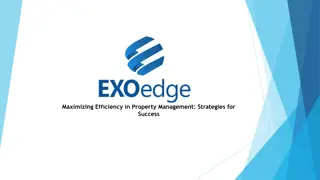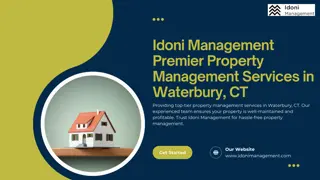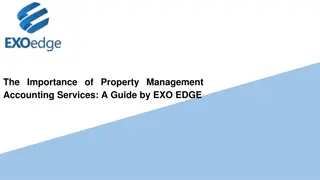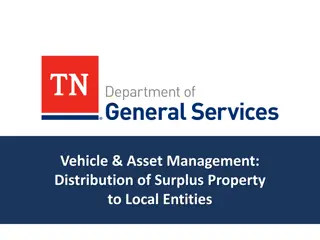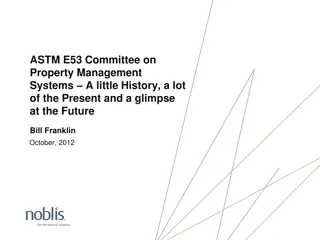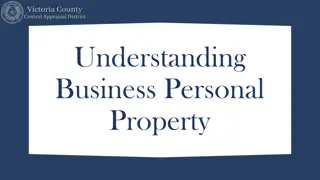Tangible Property Regulations Overview
Dive into the key aspects of tangible property regulations with insights on safe harbors, unit of property, repairs vs. improvements, and dispositions. Explore why discussing these regulations is crucial for maximizing tax benefits and avoiding pitfalls. Discover how routine maintenance safe harbors play a vital role in maintaining assets efficiently within regulatory guidelines.
Download Presentation

Please find below an Image/Link to download the presentation.
The content on the website is provided AS IS for your information and personal use only. It may not be sold, licensed, or shared on other websites without obtaining consent from the author.If you encounter any issues during the download, it is possible that the publisher has removed the file from their server.
You are allowed to download the files provided on this website for personal or commercial use, subject to the condition that they are used lawfully. All files are the property of their respective owners.
The content on the website is provided AS IS for your information and personal use only. It may not be sold, licensed, or shared on other websites without obtaining consent from the author.
E N D
Presentation Transcript
2023 ASCSP Webinar December 12, 2023
Tangible Property Regulations Candace Orr, CCSP Source Advisors Director, Tax Accounting Methods & Credits
Agenda 01Tangible Property Regulations Overview 02Safe Harbors 03 Unit of Property, Major Component & Substantial Structural Part 04Repairs vs Improvements 05Dispositions
Tangible Property Regulations (TPR) Overview
Why Discuss the Tangible Property Regs? Due to state tax non-conformity, businesses leave money on the table by relying exclusively on bonus depreciation or 179 expensing. 1. Not all capital expenditures are eligible for bonus depreciation or 179 expensing. 2. A cost treated as a repair expense instead of a depreciable asset avoids depreciation recapture upon the sale of the property. 3. For most 3115s filed in 2014-2015, the 5-year item eligibility rule now allows automatic changes. 4.
Tangible Property Regulation Overview Materials & Supplies Dispositions / GAA Elections Safe Harbors De Minimis Safe Harbor Repairs Generally effective for years beginning on or after January 1, 2014
Routine Maintenance Safe Harbor Examples Include: Inspections Cleaning Testing The replacement of parts of the Unit of Property (UoP) with comparable & commercially available & reasonable replacement parts Routine maintenance is maintenance to keep an asset in its ordinarily efficient operating condition Non-building Routine Maintenance Safe Harbor Routine Maintenance expected to be performed more than once during UoP s class life. Class life generally is the Alternative Depreciation System class life Building Routine Maintenance Safe Harbor Routine Maintenance expected to be performed more than once during the 10-year period beginning with when the UoP is placed into service by the taxpayer.
Small Taxpayer Safe Harbor Election to not capitalize repairs, maintenance, or improvements Taxpayers with three-year average gross receipts not to exceed $10 million Owned or leased buildings with cost less than $1 million All costs cannot exceed the lessor of: 2% of the unadjusted basis of the building, or $10,000 Annual election (irrevocable) Building-by-building analysis
De Minimis Safe Harbor Election Elect to apply de minimis to deduct amounts paid to acquire or produce property as taxpayer does for financial accounting purposes (book) Property costing less than a specified dollar amount, or Property with a useful life of 12 months or less Taxpayer has an Applicable Financial Statement (AFS) Must have a written accounting policy in place at the beginning of the taxable year Amount does not exceed $5,000 per invoice or per item Taxpayer does not have an AFS Policy in place at the beginning of taxable year consistent with taxpayer s books and records Amount does not exceed $2,500 per invoice or per item (eff. 1-1-2016) Requires an annual election; written statement filed with tax return Does not include or applied to Amounts paid for land Rotatable, temporary, or stand by emergency spare parts
Unit of Property, Major Component & Structural Part
What is a Building Unit of Property What is a UoP ? 1.263(a)-3(e) The UoP is the reference point upon which the capitalization standards are applied. The smaller the UoP, the more likely that costs incurred for the UoP will have to be capitalized Non-Building UoP Except for network or plant assets, all components that are functionally interdependent comprise a single UoP. Components are functionally interdependent if the placing in service of one component by the TP is dependent on the placing in service of the other component by the TP. Building UoP - each building & its structural components generally is one UoP Amounts are treated as paid for an improvement to a building if they improve: (1) the building structure; or (2) any designated building system. The 10 tests are applied to each building system If the cost is a capital expenditure for that building system, it will be treated as an improvement to the entire building.
Unit of Property Systems Major Components of Building Systems Air handling units, boilers, condensing units, fans, furnaces, heat exchangers, heat pumps, make-up air units, refrigeration compressors, water chillers, etc. Bathtubs, piping, pumps, sinks, toilets, urinals, water heaters, etc. HVAC Plumbing Generators, light fixtures, panel boards, safety switches, switchboards, transformers, etc. Car, cables & pullies, control equipment, handrails, stairs, and wheels Electrical Elevators & Escalators Alarms, emergency exit signs & lights, heat & smoke detection devices, sprinkler heads & mains, water piping, etc. Alarm systems, electronic access systems, locks, monitoring devices such as cameras, etc. Meters & gas distribution pipes Fire Protection & Alarm Security (Building) Gas Distribution Building UoPs: Building structure Condos and co-ops Leased buildings and portions of buildings Non-Building UoPs: Plant Property Network Assets Leased non-building property
Major Component & Substantial Structural Part Restoration tests for buildings often depend on the definitions of major components & substantial structural part Major component - focuses on the function of the component in the UoP A major component is defined as a part or combination of parts that performs a discrete and critical function in the operation of the UoP; Building major components may include all windows, all doors, the roof, etc. HVAC system major components may include all rooftop units, boilers, etc. Substantial structural part - focuses on the size of the replacement component in relation to the UoP A substantial structural part is defined as a part or combination of parts that comprises a large portion of the physical structure of the UoP
Major Component & Substantial Structural Part No bright line tests for determining major components. Examples show that the replacement of 30% - 40% of a major component (such as replacing 8 of 20 sinks) does not constitute the replacement of a major component Multi-year projects must be taken into account in their totality Replacing 30%-40% of a major component in one year may be ok; but, if it is a precursor to replacing more/all of a major component over multiple years it would constitute a replacement of that major component and must be capitalized Foreknowledge and intent is important
Repairs vs. Improvements 263(a) states that no repairs deduction is allowed for: Any amount paid out for new buildings or permanent improvements or betterments made to increase the value of any property, or Any amount expended in restoring property or in making good the exhaustion thereof for which an allowance has been made. 263(a) Regulations state that capital expenditures include amounts paid or incurred for betterments, adaptions to a new or different use, and restorations. 1.162-4(a) allows amounts not otherwise required to be capitalized under 263(a) to be deducted as repairs.
Repairs vs. Improvements Leasehold or Tenant Improvements (ATG Insights) Breaking out 1245 assets from 1250 improvements is the first step when dealing with TI s. A newly acquired 1245 asset like a desk, carpet, or a file cabinet is capitalized as the acquisition of a new asset/UoP when replacing prior tenant improvements. (These assets still may qualify for expensing under another provision, like the DMSH, 179, or bonus depreciation.) After breaking out 1245 assets, taxpayers then apply the BAR tests to 1250 improvements. The Service views 263A as an independent capitalization provision. A tenant improvement that is not an improvement under the BAR tests might require capitalization under 263A.
Repairs vs. Improvements Define Unit of Property & Applicable Building System HVAC, Plumbing, Electrical, Escalators, Elevators, Fire Protection & Alarm, Security & Gas Distribution Systems Building 1. Adaption of the Unit of Property to a New or Different Use? No Yes 10 Tests in 3 Categories 2. Betterment to the Unit of Property? Yes Capitalize Material condition or defect at acquisition or production Material increase in quality, capacity, productivity, efficiency, or production Material addition or expansion No 3. Restoration to the Unit of Property? Yes Return to former operating condition (no longer functioning) Rebuild the property to like new condition after class life Replacement or recognition of loss on disposed component Basis Replacement of major component or substantial structural part Gain/Loss on sale of a component adjustment as a result of a casualty loss No Expense
Adaptation New or Different Use Manufacturing plant to showroom space Develop land used for manufacturing plant as residential housing Retail drug store converts area of pharmacy to walk-in medical clinic An amount paid to adapt UOP to a new or different use if the adaption is not consistent with the TP s ordinary use of the UOP at the time originally placed in service. Not a New or Different Use Three leased retail spaces into one leased retail space Preparing building for sale Hospital modifies emergency room to also provide outpatient surgery clinic
Betterment Capitalized Cost Amelioration of pre-existing condition or defect Addition (enlargement, expansion, extension increase in capacity TP adds a stairway and mezzanine for the purpose of adding additional selling space within its building [Example 19] Material increase in the quality, capacity, productivity, strength, or efficiency Reduce energy cost by adding new insulation [Example 21] Remediate land for contamination from leaks in underground gasoline storage [Example 1) Deductible Repair Cost Not amelioration of pre- existing condition or defect Not an addition (enlargement, expansion, extension increase in capacity Remove drop ceiling, and repaint original ceiling [Example 18] Nota a material increase in the quality, capacity, productivity, strength, or efficiency Replace 2 if 10-roof-mounted HVAC units [Example 20] Asbestos removal [Example 2]
Betterment UoP Bldg. Examples Real Property Expenditure UoP Decision Restaurant Stand Alone Restaurant Shopping Mall (leased space) Retail Store Owned Refinish wood floors Building Structure Expense Replace water piping in kitchen Lease portion of building plumbing system HVAC System Expense Replace all RTU HVACs Capital Retail Store - Lease Paint exterior of building Leased portion of building structure Building structure Expense Manufacturing Plant Relocate and replace lighting fixtures Replacement of entire roof (including decking) Expense Manufacturing Plant Building Structure Capital
Betterment Refresh/Remodel Example 6: Refresh Example 7: Building refresh; limited improvement Assume same facts as example 6 plus: Assume same facts as example 7 plus: Example 8: Major remodel Consists of cosmetic and layout changes to store interior, and general repair and maintenance to modernize building Replacing and reconfiguring display tables and racks; including moving walls, relocating lighting and repairing floors to accommodate redesign Lighting relocations; replacing damaged ceiling tiles Repainting; patching holes in walls; replacing damaged ceiling tiles Cleaning and repairing wood flooring Increase in buildings footprint by constructing new loading dock and adding second overhead door Replace exterior walls with windows; rebuilding and removing walls, rebuild facades Upgrade electrical system to provide lighting and power to new space Replace vinyl flooring with ceramic tile; replace ceiling tile with acoustical tile Remodel bathrooms with higher quality material Replace the escalators; add an elevator Power washing building exteriors Refresh activities are not betterment Upgrade electrical to increase capacity The physical nature of the work and the effects of the building structure and system results in betterment of building s structure and several of its systems Cost related to example 6 (refresh) are not capitalized; Costs associated with the addition are a betterment and capitalized in accordance with 263a
Restoration UOP Restoration Not Restoration Major component or substantial structural part Not a major component/substantial structural part Building Structure - Roof HVAC System Replacement of the entire roof (decking, insulation) [Example 14] Replace chiller in office HVAC system (consists of one chiller, one boiler, pumps, duct work, diffusers, air handlers) [Example 17] Replacement of roof waterproof rubber membrane [Example 15] Replacement of one furnace HVAC system consists of three furnaces, duct work, etc. [Example 17] Replacement of three of 10 rooftop units in HVAC system HVAC system consists of 10 rooftop units, ductwork, etc. [Example 18] Replace 30% of wiring to meet building code [Example 21] Electrical System Replace wiring throughout the building to meet building code [Example 20] Retail business replaces the plumbing fixtures in all restrooms (no piping) two floors [Example 22] Hotel replaces all bathtubs, sinks in hotel rooms in four of the 20 floors; intends to complete renovation of the remaining rooms over next two years [Example 24] Replaces 200 of the 300 exterior windows (total windows are 25% of the building surface area) [Example 26] Plumbing System Replace eight of 20 sinks in restrooms in a retail store (no piping) [Example 23] Building Structure - Restroom Building Structure - Windows Replace 100 of 300 exterior windows (windows cover 25% of exterior surface) [Example 25] Building Structure - Floors Replace all floors in the public areas of a hotel public areas represent 40% sq ft [Example 28] Replace flooring in lobby 10% of the sq ft of the entire hotel building [Example 29]
Typical Qualifying R&M Deductible Expenditures Doors/Windows - Replacing or repairing door closers, locks, handles and glass, laminate covering on interior doors, and existing windows or window glass Electrical - Replacing or repairing transformers or circuit breakers, light fixtures, ballasts or bulbs, existing conduit and wire, switches and receptacles Exterior Bldg. - Repainting the building s exterior, repairing roof leaks or replacing the roofing membrane, repairing or replacing gutters and downspouts, and resealing or recaulking existing exterior components Floor/Wall - Replacement of sections of drywall on existing walls, repainting existing areas, replacing existing handrails attached to walls, and tile replacement HVAC - Replacing defective or damaged component parts such as; line driers, sensors, compressors, condenser coils, fan motors, blowers, and heat exchangers, and separate RTU units Plumbing - Replacing piping, unclogging or cleaning out existing piping, replacing existing valves, traps and drains, sinks, urinals, toilets, replacing existing water heaters, and repairing or replacing plumbing equipment to real property Restrooms - Replacing or repairing partitions, fixtures, dryers, or any hardware associated with these items Security/Fire - Replacing or repairing control panels, wiring, replacing batteries, recharging extinguishers, replacing sprinkler heads, and replacing other components of the system Doors/Windows - Replacing or repairing door closers, locks, handles and glass, laminate covering on interior doors, and existing windows or window glass
Typical Qualifying R&M Deductible Expenditures Personal Property Typically the replacement of each Sec. 1245 property is capital Amount paid to refinish, relocate, and reinstall property can be expensed. Land Improvements Restriping, repaving, minor repairs to sidewalk, curbing etc. Removal of landscaping Repairs to irrigation system (e.g. replace heads, replace small portion of piping) Repairs or replacement of portion of fence Pool resurfacing, misc. pool repairs
Special Rules Costs Incurred during an improvement: If an expenditure directly benefits or was incurred by reason of another capital activity, then the cost must be capitalized. Removal Cost: If a taxpayer disposes of a depreciable asset, including a partial disposition, and has taken into account the adjusted basis of the asset or component of the asset in realizing a gain or loss, the costs of removing the asset or component are not required to be capitalized. Election to Capitalize: A taxpayer may elect to capitalize expenditures for repair and maintenance costs incurred in carrying on a trade or business. If elected, the provision applies to all amounts paid in that year for repairs and maintenance to tangible property. The costs are treated as improvements to tangible property and as an asset subject to depreciation
Dispositions A disposition is a transfer of ownership of an asset or the permanent withdrawal of an asset from the business through: Sale or exchange Transfer to a supplies, scrap or similar account Retirement of a structural component of a building Involuntary conversion Retirement Physical abandonment Destruction Dispositions regs. apply to Single Asset Accounting (SAA), Multi Asset Accounting (MAA) & General Asset Accounting (GAA) rules
Dispositions Partial Asset Disposition Entire Asset Disposition Dispositions of entire assets are not elective Partial dispositions are generally elective however required in cases of: Casualty Event Step in shoes transaction Gain not recognized under 1031 or 1033 Sale of a portion of an asset Yes Yes Did TP Elect to Treat as a Disposition? No Determine Gain/Loss & Adjustment of Basis Under 1001, 1016, etc Was it a: Yes Casualty Event Step in shoes transaction Gain not recognized under 1031 or 1033 Sale of a portion of an asset No No Recognition of Gain/Loss & No Adjustment of Basis
Dispositions Method for identifying dispositions: The TPR require taxpayers to use any reasonable method to determine disposed assets in a GAA, MAA or portions of a larger asset. The choice of a reasonable method is an accounting method election. Non-exclusive examples of reasonable methods: 1. Discounting the cost of the replacement asset to its placed-in-service year cost using the Producer Price Index; 2. A pro rata allocation of the unadjusted depreciable basis of the GAA or MAA, as applicable, based on the replacement cost of the disposed asset and the replacement cost of all of the assets in the GAA or MAA, as applicable; and 3. A study allocating the cost of the asset to its individual components
Dispositions 280B Adjusted basis & demolition costs of a demolished building are capitalized to a non- depreciable land account Rev. Proc. 95-27 provided a safe harbor for 280B. Work on a building is not considered a demolition as long as both: 1. 75% or more of the existing external walls are retained as internal or external walls, & 2. 75% of more of the existing internal structural framework is retained in place This allows some taxpayers to use a PAD when demolishing a substantial portion of a building.
Dispositions GAA Elections & 280B On a timely filed return for the year a building is placed in service, a TP can elect to place a single building into a General Asset Account (GAA) Generally, cannot take PADs for assets in a GAA. If a TP intends to demolish a building a few years after acquisition, elect GAA status for the building. When the building is demolished, 280B will not apply. Instead, the building keeps depreciating over 27.5 or 39 years.


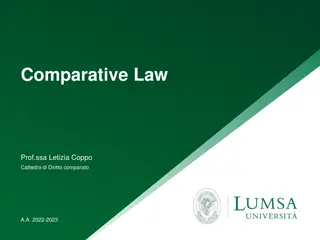
![Property Settlements in Family Law: Case Study of Stamatou & Stamatou [2022] FedCFamC1F 241](/thumb/63303/property-settlements-in-family-law-case-study-of-stamatou-stamatou-2022-fedcfamc1f-241.jpg)



